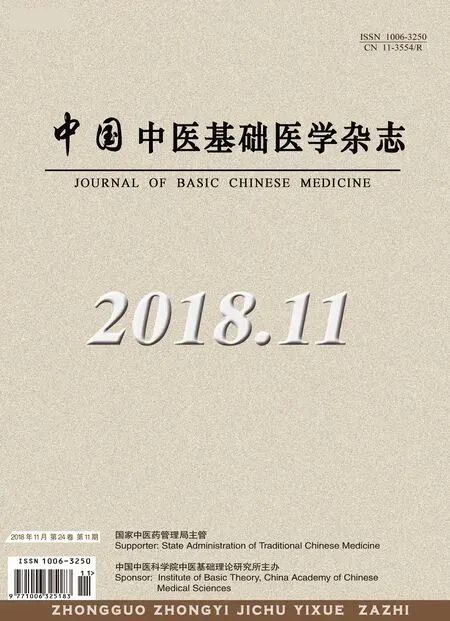《黄帝内经》核心文化术语“邪”的语境差异化英译研究❋
,△
(1. 南京中医药大学中医文化研究中心,南京 210023; 2. 河南中医药大学外语学院,郑州 450008)
《内经》是中医理论的奠基之作,是中国传统文化的重要组成部分。“邪”是中国传统文化的重要概念,更是《内经》的核心文化术语。不同中医双语辞典对“邪”的翻译也不尽相同,“邪”的英译主要有“evil”[1]“pathogen”[2]“pathogenic factors”[3]等。目前关于《内经》中“邪”的英译文章并未见到,本文正是从实证研究的角度出发,研究《内经》3个英译本对“邪”的翻译策略,总结《内经》核心文化术语“邪”的语境差异化翻译方法。
1 《内经》“邪”的涵义分析和词性分类
1.1 《内经》中“邪”的涵义分析
“邪”是中国传统文化中的常用概念,《内经》继承了传统文化的精髓,赋予“邪”医学内涵,使“邪”成为中医学的核心术语。“邪”在整个疾病的发生、发展、变化、诊断、治疗中都是重要概念。《素问·调经论》对“邪”进行了详细阐释:“夫邪之生也,或生于阴,或生于阳,其生于阳者,得之风雨寒暑;其生于阴者,得之饮食居处,阴阳喜怒。”此段论述了“邪”的产生原理,凡邪气伤人而产生疾病,或从内脏开始,或从肌表开始。从肌表开始的是由于受风雨寒暑等外部的侵袭,从内脏开始的是由于饮食失宜、起居无常、房事过度和喜怒不节所造成[4],凡能致人以病者皆邪气也。
《内经词典》[5]认为“邪”的涵义有4种:一是各种致病因素与正气相对,分为外来之邪、内生之邪。外来之邪是指风、寒、暑、湿、燥、火六淫和疫疠之气等致病因素。内生之邪是指由脏腑机能失调或因此形成的病理产物(痰饮、瘀血等);二是不正当,邪恶;三是通斜,不正,偏斜;四是语末语气词,相当于“吗”或“呢”。
1.2 《内经》中“邪”的词性分类
《内经》中共见“邪”字458处,《素问》236处,其中正文235处,目录1处;《灵枢》222处,其中正文217处,目录5处[6]。为方便讨论“邪”的翻译方法,根据“邪”所在的具体语境,将“邪”分为名词类、动词类、副词类和助词类[7]。名词类“邪”一般位于句首或句中,也会搭配其他字构成特定的中医名词术语,如“邪风”“邪气”“邪客”“邪疾”“虚邪”等。动词类“邪”多单独出现且位于句中。副词类“邪”通“斜”,指经络走向。助词类“邪”较少,多位于句末,表示疑问或反问。

表1 “邪”的分类及举例
2 《内经》英译本的选择
《内经》的翻译始于1925年,到目前为止国内外共出版15部《内经》英译本。选择的三部《内经》英译本,一是伊尔扎·威斯Ilza Veith的TheYellowEmperor’sClassicofInternalMedicine(简称威译本),Ilza Veith翻译了《黄帝内经·素问》的前34章;二是李照国的全译本HuangdiNeijing-YellowEmperor’sCanonofMedicine(简称李译本);三是罗希文的IntroductoryStudyofHuannDiNeiJing(简称罗译本),罗希文翻译了《黄帝内经·素问》的前22章。选择这三个译本是想比较在中西方不同文化背景下,不同时期的译者对《内经》核心文化术语“邪”含义的理解和翻译。
3 《内经》英译本中“邪”的英译分析
3.1 名词类“邪”的英译分析
例1: 天明则日月不明,邪害空窍(《素问·四气调神大论》)。
威译本: If Heaven opened up completely then sun and moon would never be bright, evil would come during this period of emptiness[8].
李译本: [If] the sky is bright, the sun and the moon will become dim. [As a result,] Xie (Evil) harms Kongqiao (external orifices)[9].
罗译本: When the sky is not clear and bright, the sun and the moon will lose their brightness. Then pathogenic factors will permeate among the great void[10].
分析: “邪害空窍”是指人体的孔窍受到了邪气的侵袭,此语境中“邪”是指各种致病因素。威斯直译为名词“evil”,李照国采用音译加注释翻译为“Xie”(Evil),罗希文根据“邪”所在的具体语境涵义意译为名词“pathogenic factors”。
例2: 故邪不能伤其形体,其病生于内,其治宜毒药(《素问·异法方宜论》)。
威译本: Hence evil cannot injure their external bodies, and if they get diseases they strike at the inner body. These diseases are most successfully cured with poison medicines[8].
李译本: [That is why] Xie (Evil) cannot attack their body. Their illness is usually endogenous and can be treated by Duyao (drugs)[9].
罗译本: Therefore people are not easily affected by exogenous evil factors. But diseases stem from within. Adoption of poisonous drugs (medicinal drugs) is the cure[10].
分析: “邪不能伤其形体”是指外邪不容易侵犯他们的形体,此语境中的“邪”是外来之邪。威斯直译为名词“evil”,李照国采用音译加注释翻译为“Xie”(Evil),罗希文根据具体语境意译为名词“exogenous evil factors”,将外来之邪的含义准确传递出来。
例3:故邪气胜者,精气衰也(《素问·玉机真藏论》)。
威译本: When evil influences are victorious, the secretions deteriorate[8].
李译本: Hence, when Xieqi (Evil-Qi) is superabundant, Jingqi (Essence-Qi) must decline[9].
罗译本: But when exogenous pathogenic factors become dominant in the body, Vital Essence will be totally consumed and becomes exhausted[10].
分析: 此语境中的“邪气”指外来之邪,威斯直译为名词“evil influences”。李照国采用音译加注释翻译为“Xieqi” (Evil-Qi)。罗希文根据“邪”所在具体语境中的含义意译为名词“exogenous pathogenic factors”,准确传递了外来之邪的含义。
例4: 是以春伤于风,邪气留连,乃为洞泄(《素问·生气通天论》)。
威译本:This is how one is hurt by the wind, and then the evil influences will remain in the body and create a leakage[8].
李译本:Attack by wind in spring will lead to Dongxie (acute diarrhea) if Xieqi (Evil-Qi) lingers [in the body][9].
罗译本:Invasion of pathogenic Wind in spring will cause excessive diarrhea in summer[10].
分析: 此语境中的“邪”特指风邪,意为假如春天伤了风气,风邪逗留不去。威斯直译为名词“evil influences”,李照国采用音译加注释翻译为“Xieqi” (Evil-Qi),罗希文将“邪”意译为名词“pathogenic Wind”,精确传递了“邪”的语境含义。
例5: 是以嗜欲不能劳其目,淫邪不能惑其心(《素问·上古天真论》)。
威译本:No kind of desire can tempt the eyes of those pure people and their mind cannot be misled by excessiveness and evil[8].
李译本: That is why improper addiction and avarice could not distract their eyes and ears, obscenity and fallacy could not tempt their mind[9].
罗译本: Their eyes are not tempted by addictions and desires, their minds are not attracted by lewdness and obscenity[10].
分析: 此语境中的“淫邪”为内生之邪。威斯意译为名词“excessiveness and evil”,对“淫邪”的内涵没有精确传递。李照国意译为名词“obscenity and fallacy”,罗希文意译为名词“lewdness and obscenity”,后两位译者均精确传递了“淫邪”的语境含义。
例6: 五脏皆偏倾者,邪心而善盗(《灵枢·本脏》)。
李译本:[If] the Five Zang-Organs are all slant [in location], [the person] is vicious, often steals things[11].
分析: 这句话意为:五脏位置都偏斜的人,多有私心杂念,贪利好盗。此语境中的“邪”指不正当、邪恶。李照国翻译为形容词“vicious”,准确传递了语境含义。
3.2 动词类“邪”的英译分析
例7: 非其位则邪,当其位则正(《素问·五运行大论》)。
李译本: [If it emerges in the season in which] it should not appear, [it will become] Xie (Evil); [if it emerges in the season in which] it should appear, [it is] Zheng (Healthy-Qi)[9].
分析: 此语境中的“邪”意为“变为邪气”。李照国准确把握“邪”的词性和含义,翻译为动词“[become] Xie (Evil)”。
3.3 副词类“邪”的英译分析
例8: 肾足少阴之脉,起于小指之下,邪走足心《灵枢·经脉》。
李译本: The Kidney Channel of Foot-Shaoyin starts from the inferior side of the little toe and runs obliquely towards the sole[11].
分析: 此语境中的“邪”与“斜”意同,指经络的走向。李照国翻译为副词“obliquely”,准确传递了“邪”的语境含义。
这里需要补充说明的是,由于威斯仅翻译了《黄帝内经·素问》的前34章,罗希文仅翻译了《黄帝内经·素问》的前22章,而例7出自《黄帝内经·素问》第67章,例6和例8出自《黄帝内经·灵枢》,所以只列举了李照国的译文。
3.4 助词类“邪”的英译分析
例9: 人年老而无子者,材力尽邪?将天数然也《素问·上古天真论》?
威译本: When people grow old then they cannot give birth to children. Is it because they have exhausted their strength in depravity or is it because of natural fate[8]?
李译本: Old people cannot give birth to any children. Is it due to the exhaustion of Caili (Essence-Qi) or the natural development of the body[9]?
罗译本: When people get old, they will lose the ability of bearing children. Is it because they have exhausted the energy or because of natural destiny[10]?
分析: 此语境中的“邪”为助词,表示反问。威斯没有意识到“邪”在此处为助词,而是按照“邪”的字面意思翻译为“depravity”,为误译。李照国和罗希文准确理解了“邪”在此语境中的词性和作用,均未对“邪”进行翻译。
4 《内经》英译本中“邪”的英译策略分析
4.1 李译本中“邪”的英译策略分析
李照国在翻译名词类“邪”时,根据具体语境差异主要采取音译加注释的方法,将致病因素之“邪”翻译为“Xie”(Evil),“Xieqi” (Evil-Qi);内生之“淫邪”意译为“obscenity and fallacy”;将不正当、邪恶之“邪”进行词性转换,翻译为形容词“vicious”。在翻译动词类“邪”时,保留词性翻译为“[become] Xie (Evil)”。在翻译副词类“邪”时,按照字面意思译为副词“obliquely”。在翻译助词类“邪”时,准确理解 “邪”在语境中的作用,未对“邪”进行翻译。
4.2 威译本中“邪”的英译策略分析
威斯认为,《内经》中“邪”的含义丰富,在英语中并没有与“邪”完全对应的词语。威斯多采用直译的方法,将名词类“邪”翻译为“evil”或“evil influences”,或采用意译的方法翻译为“excessiveness and evil”。威译本对“邪”的翻译比较统一、连贯性强,但在翻译时没有逐字逐句考究其具体语境中“邪”的词性和含义,译文准确性不高[12],翻译等效性相对较差。
4.3 罗译本中“邪”的英译策略分析
罗希文在翻译“邪”时,根据不同语境中“邪”的含义和词性,对名词类“邪”多采用意译的方法。如将外来之邪翻译为“exogenous pathogenic factors”,“exogenous evil factors”或“pathogenic Wind”,致病因素总称之“邪”翻译为“pathogenic factors”;内生之“淫邪”翻译为“lewdness and obscenity”。翻译助词类“邪”时,准确把握“邪”所在的语境作出恰当的翻译。罗译本区分了“邪”在不同语境下的含义和词性,对“邪”进行了准确翻译,译文连贯性强,可读性好。
5 《内经》中“邪”的语境差异化英译方法
5.1 使用 “自然对应词”
“自然对应词”是指选来译解的英文词语,其所指的含义、现象对于英文语系的一般人而言,与中医原词语对于一般的中国人而言并无二致。根据语境的差异化,可以选择相应的“自然对应词”[13]。如“邪走足心”中“邪”为副词,语境含义为“斜”,就可以选用“自然对应词”翻译为副词“obliquely”。
5.2 使用“等化性对应词”
“等化性对应词”主要是指英文字面上的意义与中文原词字面上的意义大体相同者,不过这些词在英文中从未曾被用于表达类似中文原词在中医学所具有的特殊含义[13]。“邪”是以比喻方式形成的中医术语,可以采用“等化性对应词”加以译解。如名词类“邪”可以根据字面意思直译为“evil”或“evil influences”,或是取其“致病因素”而非根据字面含义翻译为“pathogenic factors”。
5.3 借用汉语拼音音译加注释
“邪”是中医特有的概念,在译入语中无法找到精确的对应词,此时可直接借用汉语拼音翻译,并加上注释,更易于读者理解在差异化的语境中“邪”的含义。如将名词类“邪”翻译为“Xie (Evil)”或“Xieqi (Evil-Qi)”,动词类“邪”翻译为“[become] Xie (Evil)”。
6 结语
《内经》中的“邪”是中医基础理论中病因学说的核心术语,在具体语境中含义丰富,词性也不尽相同,可分为名词类、动词类、副词类和助词类。“邪”所在的语境差异给准确翻译带来了困难。通过比较不同文化背景译者的《内经》英译本,分析英译本对 “邪”的翻译策略和方法,根据《内经》中“邪”的词性差异及具体语境,给出相应的语境化差异翻译方法:使用“自然对应词”、使用“等化性对应词”和借用汉语拼音音译加注释。这种根据中医文化术语所在语境的差异性进行翻译的方法,对中医术语翻译具有重要的指导意义。

